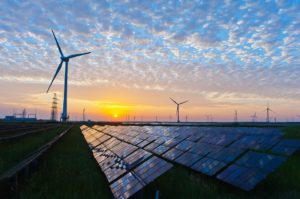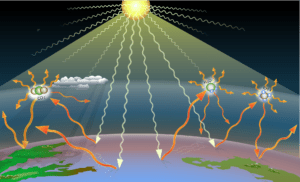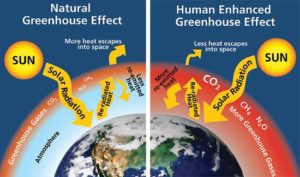What is Energy?
Energy is the ability to do work, to make things happen, and to cause changes. All life on earth depends on energy. What are some ways that you use energy? Playing outside? Riding a bike? Brushing your teeth? Reading a book? All of those activities take energy. There are other ways that you use energy; turning on the lights, riding in a car or bus, cooking food on the stove. Energy is everywhere. You can’t always see energy or touch it, but it is there.
A form of energy that you may be familiar with is electricity. How is electricity produced?

Electricity can be produced a number of ways. One way is at a power plant where gas is burned, and then heat is created. The heat turns into steam, much like when you boil water in a pot. The steam at a power plant is so powerful that it can move a turbine motor or generator! The generator then produces electricity. In order to produce electricity in this way we need to burn a fossil fuel – gas.
In a solar panel, the solar-powered photovoltaic (PV) panels change the energy and heat from the sun’s rays into electricity. No need for burning anything.

Renewable vs. Non-Renewable Energy Sources
Energy sources can either be a Renewable Energy Source, or a Non-Renewable Energy Source. What do you think those words mean?

A renewable energy source is an energy source that will always be available, and will never run out. These sources of energy are clean sources of energy. For example, one renewable energy source would be solar panels. Solar panels are a renewable energy source because they capture the energy from the sun’s heat and turn it into electricity for people to use. The sun’s heat will always be available to us, therefore it is considered a renewable energy source. Another renewable energy source are wind turbines. They get their energy from the power of the wind. Why is that renewable? Because we will always have wind!

A non-renewable energy source is what you would imagine being the opposite of renewable. This type of energy source will run out and can not be easily replaced. Some examples of non-renewable energy sources include coal, oil, and gas. In order to get energy from these we have to burn them to create heat.
These are what we call fossil fuels. Can you guess why those are called fossil fuels? Or why they are considered non-renewable? These sources are called fossil fuels because they formed when plants and animals died millions of years ago. Over time, they became buried deeper and deeper underground, where the heat and pressure began to rise. The dead plants and animals then were formed into substances like oil, coal, and gas. Therefore, once we remove and burn all the fossil fuels buried under the earth, we would have to wait millions of years for more to be formed! This is why it is called a non-renewable energy source.

Why do we want to save energy?
Anytime you use energy generated by non-renewable resources like gas, oil, or coal, you are using natural resources. Most of these natural resources are limited and are quickly running out. When we use natural resources, like gas for example, we are also polluting the air. Air pollution has a negative impact on human, animal, and plant health. When we burn those resources like gas, oil, and coal, we are increasing the amount of greenhouse gases in the atmosphere which trap heat, and are warming our planet.
In addition, if we run out of these natural resources, not only will we have no power to turn on our lights, but lots of ecosystems will be diminished, and it will take years to replenish that natural resource. So, the more energy we save, the less natural resources will be used, the healthier air we have, thus creating a better environment for all.

This photo is of the tar sands in Alberta (2008). This is an area where they are extracting oil (a fossil fuel) for humans to use.
The Carbon Cycle
Carbon is an important element for all life on Earth. Carbon can be found in many different forms having vastly different properties.
Carbon is present in all four major spheres of the planet: biosphere (the parts of the land, sea, and atmosphere in which life can exist), hydrosphere (all of the Earth’s water), atmosphere (the gases surrounding the Earth), and lithosphere (rocky outer layer of Earth). Carbon is present in the living and non-living parts of the earth. Carbon makes up approximately 50% of all living tissues. Carbon can also be found in rocks, atmospheric gases, and water!
The amount of carbon on the earth stays pretty much the same, it just moves from one sphere to another in an ongoing process known as the carbon cycle.
The carbon cycle is a process in which carbon atoms continually travel from the atmosphere to the Earth, then back into the atmosphere.

We all encounter carbon throughout our daily lives. Our bodies contain carbon, the air we breathe contains carbon dioxide, the food we eat contains carbon, and even the clothes we wear contain carbon! Through our use of carbon-containing materials, we move carbon from one place to another more quickly than would naturally happen.

An example of carbon moving from one place to another is when trees take up carbon dioxide (CO₂) and release oxygen (O₂) through photosynthesis, transferring the carbon (C) to their trunks, limbs, roots, and leaves as they grow. When leaves or branches fall and decompose, or get cut down, the stored carbon will be released by respiration and/or combustion back to the atmosphere or is transferred into the soil.
To learn more about the Carbon Cycle, watch this video!
Greenhouse Gases / the Greenhouse Effect
Some Greenhouse Gases are a natural occurrence on Earth. When volcanoes blow, they produce greenhouse gases. When plants die and decompose, they also produce greenhouse gases. These greenhouse gases are Carbon Dioxide, Methane, Water Vapor, and Nitrous Oxide. They have the ability to trap heat in the atmosphere, creating a nice blanket over Earth.

When sunlight passes through the atmosphere, the Earth’s surface absorbs some of the sunlight’s energy. Some of that energy is sent back into the atmosphere where the Greenhouse Gases trap some of it. These gases that trap the heat keep our Earth an average of 52-58 degrees. Warm enough for us to be comfortable! Without these naturally occurring gases, the Earth would be 60 degrees colder. Much too cold for most of us!
We call this process the Greenhouse Effect. A good way to think about the greenhouse effect is by imagining that Earth is inside a greenhouse. A greenhouse stays warm inside, even during the winter. In the daytime, the sunlight shines into it and warms the plants and air inside. At night, it’s colder outside, but the greenhouse stays warm inside. That is because the glass walls of the greenhouse trap the Sun’s heat. The greenhouse gases are like the glass walls of a greenhouse and trap heat to keep Earth warm.

Things like volcanoes and decaying matter are considered producers of greenhouse gases, and the oceans and trees are consumers of greenhouse gases. Naturally, there is a balance between the two. This balance is just enough to create that comfortable blanket over Earth.
Unfortunately, that balance of producers and consumers of greenhouse gases is off. More greenhouse gases are being produced, and not in a natural way. Humans are creating more greenhouse gases by burning fossil fuels. By creating more greenhouse gases, even more heat is getting trapped in the atmosphere. What does that mean for Earth? That nice cozy blanket over Earth is now getting thicker, which means it is getting warmer. This is causing the overall temperature of the Earth to rise.

What is Climate Change?
Climate change describes a change in the average conditions — such as temperature and rainfall — in a region over a long period of time. For example, 20,000 years ago, much of the United States was covered in glaciers. In the United States today, we have a warmer climate and fewer glaciers. Earth’s climate has constantly been changing, even long before humans came into the picture. However, scientists have observed the Earth’s average temperature has been increasing much more quickly than they would expect naturally over the past 150 years. It has been increasing because humans are burning too many fossil fuels, thus putting more greenhouse gases into the atmosphere that change the natural balance.

Impacts of Climate Change… Stay tuned for part 2!
Continue Learning!
There are lots of topics for you to choose from. Don’t stop here; move on to discover another lesson! New lessons uploaded each week.
